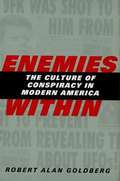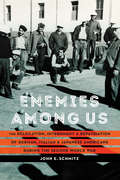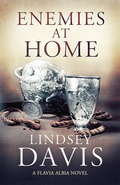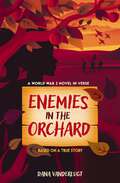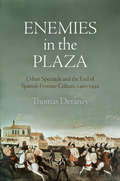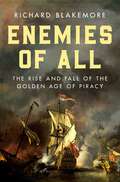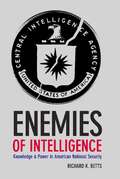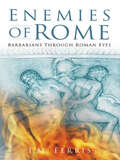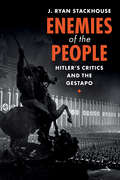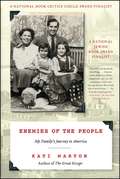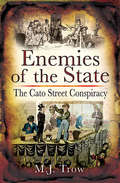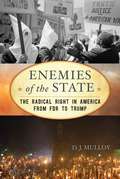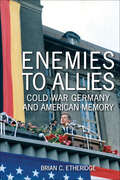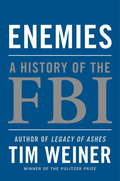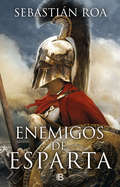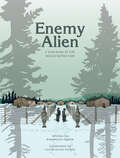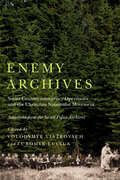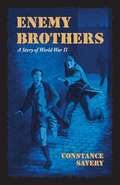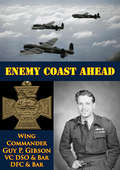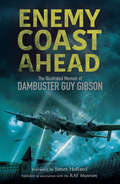- Table View
- List View
Enemies Within: The Culture of Conspiracy in Modern America
by Robert Alan Goldberg"There is a hunger for conspiracy news in America. Hundreds of Internet websites, magazines, newsletters, even entire publishing houses, disseminate information on invisible enemies and their secret activities, subversions, and coverups. Those who suspect conspiracies behind events in the news - the crash of TWA Flight 800, the death of Marilyn Monroe - join generations of Americans, from the colonial period to the present day, who have entertained visions of vast plots. In this book Robert Goldberg focuses on five major conspiracy theories of the past half-century, examining how they became widely popular in the United States and why they have remained so. "--BOOK JACKET. Title Summary field provided by Blackwell North America, Inc. All Rights Reserved
Enemies among Us: The Relocation, Internment, and Repatriation of German, Italian, and Japanese Americans during the Second World War
by John E. SchmitzRecent decades have drawn more attention to the United States&’ treatment of Japanese Americans during World War II. Few people realize, however, the extent of the country&’s relocation, internment, and repatriation of German and Italian Americans, who were interned in greater numbers than Japanese Americans. The United States also assisted other countries, especially in Latin America, in expelling &“dangerous&” aliens, primarily Germans. In Enemies among Us John E. Schmitz examines the causes, conditions, and consequences of America&’s selective relocation and internment of its own citizens and enemy aliens, as well as the effects of internment on those who experienced it. Looking at German, Italian, and Japanese Americans, Schmitz analyzes the similarities in the U.S. government&’s procedures for those they perceived to be domestic and hemispheric threats, revealing the consistencies in the government&’s treatment of these groups, regardless of race. Reframing wartime relocation and internment through a broader chronological perspective and considering policies in the wider Western Hemisphere, Enemies among Us provides new conclusions as to why the United States relocated, interned, and repatriated both aliens and citizens considered enemies.
Enemies and Neighbors: Arabs and Jews in Palestine and Israel, 1917-2017 (Books That Changed the World)
by Ian Black“Comprehensive and compelling…a landmark study” of the Arab-Zionist conflict, told from both sides, by the author of Israel’s Secret Wars (Sunday Times, UK).Setting the scene at the end of the nineteenth century, when the first Zionist settlers arrived in the Ottoman-ruled Holy Land, Black draws on a wide range of sources—from declassified documents to oral testimonies to his own vivid-on-the-ground reporting—to illuminate the most polarizing conflict of modern times. Beginning with the 1917 Balfour Declaration, in which the British government promised to favor the establishment of “a national home for the Jewish people” in Palestine, Black proceeds through the Arab Rebellion of the late 1930s, the Nazi Holocaust, Israel’s independence and the Palestinian Nakba (catastrophe), the watershed of 1967 followed by the Palestinian re-awakening, Israel’s settlement project, two Intifadas, the Oslo Accords, and continued negotiations and violence up to today. Combining engaging narrative with political analysis and social and cultural insights, Enemies and Neighbors is both an accessible overview and a fascinating investigation into the deeper truths of a furiously contested history.
Enemies at Home (Flavia Albia)
by Lindsey DavisFrom renowned author Lindsey Davis, creator of the much-loved character, Marcus Didius Falco and his friends and family, comes the second novel in her all-new series set in Ancient Rome.We first met Flavia Albia, Falco's feisty adopted daughter, in The Ides of April. Albia is a remarkable woman in what is very much a man's world: young, widowed and fiercely independent, she lives alone on the Aventine Hill in Rome and makes a good living as a hired investigator. An outsider in more ways than one, Albia has unique insight into life in ancient Rome, and she puts it to good use going places no man could go, and asking questions no man could ask.Even as the dust settles from her last case, Albia finds herself once again drawn into a web of lies and intrigue. Two mysterious deaths at a local villa may be murder and, as the household slaves are implicated, Albia is once again forced to involve herself. Her fight is not just for truth and justice, however; this time, she's also battling for the very lives of people who can't fight for themselves.Enemies at Home presents Ancient Rome as only Lindsey Davis can, offering wit, intrigue, action and the further adventures of a brilliant new heroine who promises to be as celebrated as Marcus Didius Falco and Helena Justina, her fictional predecessors.(P)2014 Hodder & Stoughton
Enemies at Home (Flavia Albia)
by Lindsey DavisWe first met Flavia Albia, Falco's feisty adopted daughter, in The Ides of April.Albia is a remarkable woman in what is very much a man's world: young, widowed and fiercely independent, she lives alone on the Aventine Hill in Rome and makes a good living as a hired investigator. An outsider in more ways than one, Albia has unique insight into life in ancient Rome, and she puts it to good use going places no man could go, and asking questions no man could ask.Even as the dust settles from her last case, Albia finds herself once again drawn into a web of lies and intrigue. Two mysterious deaths at a local villa may be murder and, as the household slaves are implicated, Albia is once again forced to involve herself. Her fight is not just for truth and justice, however; this time, she's also battling for the very lives of people who can't fight for themselves.Enemies at Home presents Ancient Rome as only Lindsey Davis can, offering wit, intrigue, action and the further adventures of a brilliant new heroine who promises to be as celebrated as Marcus Didius Falco and Helena Justina, her fictional predecessors.
Enemies at Home (Flavia Albia)
by Lindsey DavisWe first met Flavia Albia, Falco's feisty adopted daughter, in The Ides of April.Albia is a remarkable woman in what is very much a man's world: young, widowed and fiercely independent, she lives alone on the Aventine Hill in Rome and makes a good living as a hired investigator. An outsider in more ways than one, Albia has unique insight into life in ancient Rome, and she puts it to good use going places no man could go, and asking questions no man could ask.Even as the dust settles from her last case, Albia finds herself once again drawn into a web of lies and intrigue. Two mysterious deaths at a local villa may be murder and, as the household slaves are implicated, Albia is once again forced to involve herself. Her fight is not just for truth and justice, however; this time, she's also battling for the very lives of people who can't fight for themselves.Enemies at Home presents Ancient Rome as only Lindsey Davis can, offering wit, intrigue, action and the further adventures of a brilliant new heroine who promises to be as celebrated as Marcus Didius Falco and Helena Justina, her fictional predecessors.
Enemies in the Orchard: A World War 2 Novel in Verse
by Dana VanderLugtSet against the backdrop of WWII, this achingly beautiful middle grade novel in verse based on American history presents the dual perspectives of Claire, a Midwestern girl who longs to enter high school and become a nurse even as she worries for her soldier brother, and Karl, a German POW who&’s processing the war as he works on Claire&’s family farm. This poignant and moving story of an unlikely connection will stay with readers long after the final page.It&’s October 1944, and while Claire&’s older brother, Danny, is off fighting in World War II, her dad hires a group of German POWs to help with the apple harvest on their farm. Claire wants nothing to do with the enemies in the orchard, until she meets soft-spoken, hardworking Karl. Could she possibly have something in common with a German soldier?Karl, meanwhile, grapples with his role in the war as he realizes how many lies Hitler&’s regime has spread—and his complacency in not standing up against them. But his encounters with Claire give him hope that he can change and become the person he wants to be.Inspired by the little-known history of POW labor camps in the United States, this lyrical verse novel is told in alternating first-person poems by two young people on opposite sides of the war. Against a vivid backdrop of home front tensions and daily life, intimate entries reveal Claire&’s and Karl's hopes and struggles, and their growing friendship even as the war rages on. What are their chances of connection, of redemption, of peace?Enemies in the Orchard is:A gorgeously written novel in verse for ages 9 and upHistorical fiction based on true events during WWIIA heartfelt story that explores connection, trauma, and hope
Enemies in the Plaza: Urban Spectacle and the End of Spanish Frontier Culture, 1460-1492 (The Middle Ages Series)
by Thomas DevaneyToward the end of the fifteenth century, Spanish Christians near the border of Castile and Muslim-ruled Granada held complex views about religious tolerance. People living in frontier cities bore much of the cost of war against Granada and faced the greatest risk of retaliation, but had to reconcile an ideology of holy war with the genuine admiration many felt for individual members of other religious groups. After a century of near-continuous truces, a series of political transformations in Castile—including those brought about by the civil wars of Enrique IV's reign, the final war with Granada, and Fernando and Isabel's efforts to reestablish royal authority—incited a broad reaction against religious minorities. As Thomas Devaney shows, this active hostility was triggered by public spectacles that emphasized the foreignness of Muslims, Jews, and recent converts to Christianity.Enemies in the Plaza traces the changing attitudes toward religious minorities as manifested in public spectacles ranging from knightly tournaments, to religious processions, to popular festivals. Drawing on contemporary chronicles and municipal records as well as literary and architectural evidence, Devaney explores how public pageantry originally served to dissipate the anxieties fostered by the give-and-take of frontier culture and how this tradition of pageantry ultimately contributed to the rejection of these compromises. Through vivid depictions of frontier personalities, cities, and performances, Enemies in the Plaza provides an account of how public spectacle served to negotiate and articulate the boundaries between communities as well as to help Castilian nobles transform the frontier's religious ambivalence into holy war.
Enemies of All: The Rise and Fall of the Golden Age of Piracy
by Richard BlakemoreA masterful narrative history of the dangerous lives of pirates during the seventeenth and eighteenth centuries, revealing their unique impact on colonialism and empire.The pirates that exist in our imagination are not just any pirates. Violent sea-raiding has occurred in most parts of the world throughout history, but our popular stereotype of pirates has been defined by one historical moment: the period from the 1660s to the 1730s, the so-called "golden age of piracy." A groundbreaking history of pirates, Enemies of All combines narrative adventure with deeply researched analysis, engrossing readers in the rise of piracy in the later seventeenth century, the debates about piracy in contemporary law and popular media, as well as the imperial efforts to suppress piracy in the early eighteenth century. The Caribbean and American colonies of Britain, France, Spain, and the Netherlands—where piracy surged across these decades—are the main theater for Enemies of All, but this is a global story. Evoking London, Paris, and Amsterdam, Curaçao, Port Royal, Tortuga, and Charleston, the narrative takes readers, too, from Ireland and the Mediterranean to Madagascar and India, from the Arabian Gulf to the Pacific Ocean. Familiar characters like Drake, Morgan, Blackbeard, Bonny and Read, Henry Every, and Captain Kidd all feature here, but so too will the less well-known figures from the history of piracy, their crew-members, shipmates, and their confederates ashore; the men and women whose transatlantic lives were bound up with the rise and fall of piracy. Transforming how readers understand the history of pirates, Enemies of All presents not only the historical evidence but, more importantly, explains the consequences of piracy's unique influence on colonialism and European imperial ambitions.
Enemies of Intelligence: Knowledge and Power in American National Security
by Richard K. BettsThe tragic events of September 11, 2001, and the false assessment of Saddam Hussein's weapons arsenal were terrible reminders that good information is essential to national security. These failures convinced the American public that their intelligence system was broken and prompted a radical reorganization of agencies and personnel, but as Richard K. Betts argues in this book, critics and politicians have severely underestimated the obstacles to true reform. One of the nation's foremost political scientists, Betts draws on three decades of work within the U.S. intelligence community to illuminate the paradoxes and problems that frustrate the intelligence process. Unlike America's efforts to improve its defenses against natural disasters, strengthening its strategic assessment capabilities means outwitting crafty enemies who operate beyond U.S. borders. It also requires looking within to the organizational and political dynamics of collecting information and determining its implications for policy. Combining academic research with personal experience, Betts outlines strategies for better intelligence gathering and assessment. He describes how fixing one malfunction can create another; in what ways expertise can be both a vital tool and a source of error and misjudgment; the pitfalls of always striving for accuracy in intelligence, which in some cases can render it worthless; the danger, though unavoidable, of "politicizing" intelligence; and the issue of secrecy - when it is excessive, when it is insufficient, and how limiting privacy can in fact protect civil liberties. Betts argues that when it comes to intelligence, citizens and politicians should focus less on consistent solutions and more on achieving a delicate balance between conflicting requirements. He also emphasizes the substantial success of the intelligence community, despite its well-publicized blunders, and highlights elements of the intelligence process that need preservation and protection. Many reformers are quick to respond to scandals and failures without detailed, historical knowledge of how the system works. Grounding his arguments in extensive theory and policy analysis, Betts takes a comprehensive and realistic look at how knowledge and power can work together to face the intelligence challenges of the twenty-first century.
Enemies of Rome: Barbarians Through Roman Eyes
by Iain FerrisThe artists of Ancient Rome portrayed the barbarian enemies of the empire in sculpture, reliefs, metalwork and jewellery.Enemies of Rome shows how the study of these images can reveal a great deal about the barbarians, as well as Roman art and the Romans view of themselves.
Enemies of the People: Hitler's Critics and the Gestapo
by J. Ryan StackhouseHow do terror and popularity merge under a dictatorship? How did the Gestapo deal with critics of Nazism? Based on hundreds of secret police case files, Enemies of the People explores the day-to-day reality of political policing under Hitler. Examining the Gestapo's policy of 'selective enforcement', J. Ryan Stackhouse challenges the abiding perception of the Gestapo as policing exclusively through terror. Instead, he reveals the complex system of enforcement that defined the relationship between state and society in the Third Reich and helps to explain the Germans' abiding support for Hitler and their complicity in the regime's crimes. Stories of everyday life in Nazi Germany paint the clearest picture yet of just how differently the Gestapo handled certain groups and actions, and the routine investigation, interrogation, and enforcement practices behind this system. Enemies of the People offers penetrating insights into just how reasonable selective enforcement appeared to Germans, and draws unavoidable parallels with the contemporary threat of authoritarianism.
Enemies of the People: My Family's Journey to America
by Kati Marton"You are opening a Pandora's box," Marton was warned when she filed for her family's secret police fi les in Budapest. But her family history -- during both the Nazi and the Communist periods -- was too full of shadows. The files revealed terrifying truths: secret love aff airs, betrayals inside the family circle, torture and brutalities alongside acts of stunning courage -- and, above all, deep family love. In this true-life thriller, Kati Marton, an accomplished journalist, exposes the cruel mechanics of the Communist Terror State, using the secret police files on her journalist parents as well as dozens of interviews that reveal how her family was spied on and betrayed by friends and colleagues, and even their children's babysitter. In this moving and brave memoir, Marton searches for and finds her parents, and love. Marton relates her eyewitness account of her mother's and father's arrests in Cold War Budapest and the terrible separation that followed. She describes the pain her parents endured in prison -- isolated from each other and their children. She reveals the secret war between Washington and Moscow, in which Marton and her family were pawns in a much larger game. By the acclaimed author of The Great Escape, Enemies of the People is a tour de force, an important work of history as it was lived, a narrative of multiple betrayals on both sides of the Cold War that ends with triumph and a new beginning in America.
Enemies of the State: The Cato Street Conspiracy
by M. J. TrowOn 1 May 1820, outside Newgate Prison, in front of a dense crowd, five of the Cato Street conspirators—Arthur Thistlewood, William Davidson, James Ings, Richard Tidd and John Brunt—were hanged for high treason. Then they were decapitated in the last brutal act of a murderous conspiracy that aimed to assassinate Prime Minister Lord Liverpool and his cabinet and destroy his government. The Cato Street conspirators matched the Gunpowder plotters in their daring—and in their fate—but their dark, radical intrigue hasnt received the attention it deserves. M.J. Trow, in this gripping fast-moving account of this notorious but neglected episode in British history, reconstructs the case in vivid detail and sets it in the wider context of the French Revolution and the Napoleonic Wars.
Enemies of the State: The Radical Right in America from FDR to Trump (The American Ways Series)
by D. J. MulloyThe rise of the alt-right alongside Donald Trump’s candidacy may be seem unprecedented events in the history of the United States, but D. J. Mulloy shows us that the radical right has been a long and active part of American politics during the twentieth century. From the German-American Bund to the modern militia movement, D. J. Mulloy provides a guide for anyone interested in examining the roots of the radical right in the U.S.—in all its many varied forms—going back to the days of the Great Depression, the New Deal and the extraordinary political achievements of Franklin D. Roosevelt. <p><p> Enemies of the State offers an informative and highly readable introduction to some of the key developments and events of recent American history including: the fear of the Communist subversion of American society in the aftermath of the Second World War; the rise of the civil rights movement and the “white backlash” this elicited; the apparent decline of liberalism and the ascendancy of conservatism during the economic malaise of the 1970s; Ronald Reagan’s triumphant presidential victory in 1980; and the Great Recession of 2007-08 and subsequent election of President Obama.
Enemies to Allies: Cold War Germany and American Memory (Studies In Conflict, Diplomacy, And Peace Ser.)
by Brian C. Etheridge“Addresses a compelling and fascinating feature of the Cold War Era, namely the rapid reversal of America’s alliance relationships after World War II.” —Thomas A. Schwartz, coeditor of The Strained AllianceAt the close of World War II, the United States went from being allied with the Soviet Union against Germany to alignment with the Germans against the Soviet Union—almost overnight. While many Americans came to perceive the German people as democrats standing firm with their Western allies on the front lines of the Cold War, others were wary of a renewed Third Reich and viewed all Germans as nascent Nazis bent on world domination. These adversarial perspectives added measurably to the atmosphere of fear and distrust that defined the Cold War.In Enemies to Allies, Brian C. Etheridge examines more than one hundred years of American interpretations and representations of Germany. With a particular focus on the postwar period, he demonstrates how a wide array of actors—including special interest groups and US and West German policymakers—employed powerful narratives to influence public opinion and achieve their foreign policy objectives. Etheridge also analyses bestselling books, popular television shows such as Hogan’s Heroes, and award-winning movies such as Schindler’s List to reveal how narratives about the Third Reich and Cold War Germany were manufactured, contested, and co-opted as rival viewpoints competed for legitimacy.This groundbreaking study draws from theories of public memory and public diplomacy to demonstrate how conflicting US accounts of German history serve as a window for understanding not only American identity, but international relations and state power.“A masterful combination of diplomatic and cultural history.” —Stewart Anderson, Brigham Young University
Enemies: A History of the FBI
by Tim WeinerEnemies is the first definitive history of the FBI's secret intelligence operations, from an author whose work on the Pentagon and the CIA won him the Pulitzer Prize and the National Book Award. We think of the FBI as America's police force. But secret intelligence is the Bureau's first and foremost mission. Enemies is the story of how presidents have used the FBI as the most formidable intelligence force in American history. Here is the hidden history of America's hundred-year war on terror. The FBI has fought against terrorists, spies, anyone it deemed subversive--and sometimes American presidents. The FBI's secret intelligence and surveillance techniques have created a tug-of-war between protecting national security and infringing upon civil liberties. It is a tension that strains the very fabric of a free republic.From the Hardcover edition.
Enemigos de Esparta
by Sebastián Roa«Te metieron en la cabeza la idea de que Esparta es invencible, pero yo te digo que no lo es. Y no tardaremos mucho en comprobarlo.» Sebastián Roa vuelve a deslumbrar con una obra llena de épica, fuerza narrativa y rigor. Una nueva obra maestra de uno de los grandes de la novela histórica de hoy. GUERRA · AMOR · TRAICIÓN Prómaco y Veleka se aman. Pero él es un simple mercenario de sangre mestiza, y ella pertenece a la nobleza. No les queda otro remedio que huir en busca de los espartanos, a quienes Prómaco tanto admira. VIOLENCIA · SEXO · VENGANZA Cuando un altivo guerrero espartano rapta a Veleka, Prómaco jura rescatarla aunque tenga que buscarla en el corazón de la propia Esparta. Pero enfrentarse a su poderoso ejército es un sueño imposible. MUERTE · PODER · REBELIÓN O tal vez no. En Atenas, un puñado de exiliados conspira. Epaminondas, Pelópidas, Agarista, Platón... A cada uno le mueven sus razones, pero todos comparten un objetivo: recuperar la democracia arrebatada por Esparta. Críticas:«Sebastián Roa consigue que nos sintamos como si estuviéramos ahí.»El Mundo «Cuando el rigor histórico y el talento se aúnan surgen obras maestras como esta. Impresionante.»Anika Entre Libros «Una auténtica joya.»La historia en mis libros «Tramas de pasión, intriga, guerra y ambición se entrecruzan de manera magistral.»Todo Literatura «Hay que leerlo ya.»Historia o leyenda «Una novela histórica de altura y bien documentada que combina rigor informativo y aventuras verdaderamente trepidantes.»Culturamas «Una trepidante historia, minuciosamente documentada y repleta de amores, batallas, traiciones, venganzas y pasiones humanas.»Eldiario.es «El autor maneja los recursos literarios con maestría.»La Razón
Enemigos perfectos (Saga de los Malory #Volumen 10)
by Johanna LindseyLos Malory son una familia de granujas apuestos y aventureros libertinos, y damas con carácter. Una saga romántica sobre la aristocracia británica del siglo XIX, creada por el talento incomparable de Johanna Lindsey, una de las autoras más populares del género. Enemigos perfectos es la décima entrega de la emocionante «Saga de los Malory», sin duda la saga familiar más popular del género romántico. Nueve años atrás, Richard Allen huyó de Inglaterra y de su dominante padre. Decidido a vivir su propia vida, terminó por unirse a una banda de piratas cazadores de tesoros en el Caribe. Allí adoptó la identidad de un francés seductor y despreocupado, Jean Paul. Cuando regresa de incógnito a Inglaterra para lleva a cabo una tarea urgente, se enamora de Georgina Malory, una mujer casada. Pero su osado intento de cortejarla en un baile de disfraces se convierte en el peor error de su vida porque lo pone en presencia de otra hermosa mujer. Emocionada porque sus abogados por fin han encontrado la manera de liberarla de un compromiso matrimonial indeseado, Julia Miller espera encontrar al hombre de su vida en el baile de su amiga Georgina. Cautivada por un francés enmascarado, no puede evitar seguir a ese misterioso hombre...
Enemy Alien: A True Story of Life Behind Barbed Wire
by Kassandra LuciukThis graphic history tells the story of Canada’s first national internment operations through the eyes of John Boychuk, an internee held in Kapuskasing from 1914 to 1917. The story is based on Boychuk’s actual memoir, which is the only comprehensive internee testimony in existence. The novel follows Boychuk from his arrest in Toronto to Kapuskasing, where he spends just over three years. It details the everyday struggle of the internees in the camp, including forced labour and exploitation, abuse from guards, malnutrition, and homesickness. It also documents moments of internee agency and resistance, such as work slowdowns and stoppages, hunger strikes, escape attempts, and riots. Little is known about the lives of the incarcerated once the paper trail stops, but Enemy Alien subsequently traces Boychuk’s parole, his search for work, his attempts to organize a union, and his ultimate settlement in Winnipeg. Boychuk’s reflections emphasize the much broader context in which internment takes place. This was not an isolated incident, but rather part and parcel of Canadian nation building and the directives of Canada’s settler colonial project.
Enemy Archives: Soviet Counterinsurgency Operations and the Ukrainian Nationalist Movement – Selections from the Secret Police Archives
by Volodymyr Viatrovych and Lubomyr LuciukAs Russia wages a twenty-first-century war against the very existence of a Ukrainian state and nation, reanimating Soviet-era propaganda that portrayed Ukrainians as Nazi collaborators and fascists, the experiences of the Ukrainian nationalist underground before, during, and after the Second World War gain new significance. While engaged in a decades-long struggle against the Ukrainian nationalist movement and the Ukrainian Insurgent Army (UPA), and lasting into the mid-1950s, Soviet counterinsurgency forces accumulated a comprehensive and extensive archive of documents captured from the Organization of Ukrainian Nationalists and the UPA. Volodymyr Viatrovych and Lubomyr Luciuk have curated and carefully annotated a selection of these documents in Enemy Archives, providing primary sources the Soviet authorities collected and deemed useful for better understanding their opponents and so securing their destruction, a campaign that ultimately failed.The documents seized from the insurgents and Soviet analyses of them shed light on a wide range of experiences in the underground: how the movement struggled to maintain discipline and morale, how it dealt with suspected informers, and how it resisted the ruthless Soviet state, laying the foundations for the continuing Ukrainian struggle against foreign domination.
Enemy Brothers: A Story of World War II
by Constance SaveryTHEY MADE A BARGAIN... They ate their meal by the fire. A little black cat came mewing and pawing for fish. "How many lives has a cat?" Dym asked, tickling her gently under her furry chin. Tony would not answer. "Nine," said Dym. "So have you. I mean that if you run away as often as nine times you won't get into trouble when you are caught. But the tenth time you are caught running away there will be a row, a really serious row. Understand?" Tony scowled. "You've lost three of your lives already. That leaves six, doesn't it?" There were disadvantages, Tony found, in a vow of eternal silence. For example, one had no power to protest violently against such a flagrant injustice such as this. He turned his eyes glowing with indignation on Dym. "You think that's not square, eh?" But Tony was wrathfully silent. Dym's grave young face broke suddenly into a smile. Though Tony would not have owned it for the world, he liked to see his captor smile. "Not going to be tricked into speaking to me, are you, Max? I'm afraid I did it on purpose-I wanted to see whether I could make you speak. Very good, then; we'll start from tonight. You have nine lives and no more. Is that fair warning?" Tony did not answer in words. In his heart he thought it was fair enough. Thus a private war declared between Tony and the inhabitants of the White Priory. British airman Dym Ingleford is convinced that young Max Eckermann is his brother, Anthony, who was kidnapped years before. Raised in the Nazi ideology, Tony has by chance tumbled into British hands. Dym has brought him back, at least temporarily, to the family he neither remembers nor will acknowledge as his own. As Tony uses his nine attempts to escape, his stubborn anger is whittled away by the patient kindness he finds at the White Priory. Then, just as he is resigning himself to the English family, a new chance suddenly opens for him to return home-to Germany! ENEMY BROTHERS, written in the early years of World War II before the United States joined the Allied forces, is a story of faith in the face of uncertainty. As the events and relationships develop, the reader is given an inside view of the confusion war brings and the triumph of the human spirit in the midst of it. Ages 10-up
Enemy Coast Ahead [Illustrated Edition]
by Wing Commander Guy P. Gibson VC DSO Bar Dfc BarIncludes the Aerial Warfare In Europe During World War II illustrations pack with over 200 maps, plans, and photos.THE classic account of the Royal Air Force Bomber Command during World War Two.This is probably the best-known memoir by a Bomber Command Officer. The author first saw active service with 83 Squadron in 1939 flying against German naval targets. After completing 39 missions he transferred to Fighter Command where he flew as a night-fighter pilot with 29 Squadron. In 1942, he was given command of 106 Squadron. Such was his success flying Lancasters that when 617 Squadron was formed for the specific task of attacking the Ruhr valley dams, the author was given command. Awarded the VC for the famous 'Dam Busters' raid, the author was commissioned to write this book, a task which he completed shortly before his death in 1944.-Print Ed. "A remarkable piece of descriptive writing. It records the night-to-night life of a bomber pilot with modesty, humour, and a rich understanding.it is extraordinarily adult work for such a young man."..."This is a magnificent story well and simply told by as great a warrior as these islands ever bred. It is also History." Marshal of the Royal Air Force, Sir Arthur Harris
Enemy Coast Ahead: The Illustrated Memoir of Dambuster Guy Gibson (Literature And History Of Aviation Ser.)
by Guy GibsonA definitive new edition of a classic, World War II memoir, complete with more than 100 photographs, and notes from leading historians. Guy Gibson was the leader of the famous Dambusters raid, and Enemy Coast Ahead is a vivid, honest account, widely regarded as one of the best books on the Second World War. It also provides an insider&’s perspective, setting down in clear detail the challenges that the RAF faced in the war against Germany&’s Luftwaffe. Tragically, Gibson died in September 1944, when his Mosquito crashed near Steenbergen in the Netherlands. He was aged just 26. This new book has been published to mark the 75th anniversary of his death and includes an introduction by James Holland, a historian and broadcaster. It includes notes by Dr Robert Owen, the Official Historian of the No. 617 Squadron Association, and many images that have never before been published. Published in association with the RAF Museum Inspired the 1955 film The Dam Busters, starring Richard Todd and Michael Redgrave
